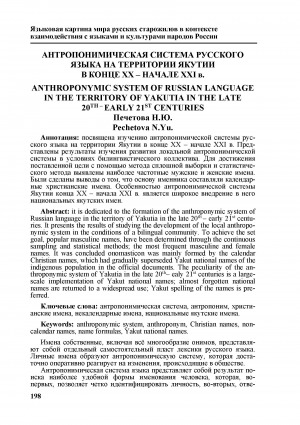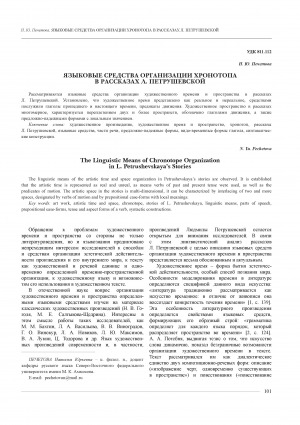Место работы автора, адрес/электронная почта: Северо-Восточный федеральный университет им. М. К. Аммосова, Филологический факультет ; 677013, г. Якутск, ул. Кулаковского, 42 ; e-mail: ny.pechetova@s-vfu.ru, pechetovan@mail.ru ; https://www.s-vfu.ru/
Ученая степень, ученое звание: канд. филол. наук
Область научных интересов: Языковые особенности печатных региональных СМИ, жанровое своеобразие печатных изданий, особенности функционирования имен собственных в художественных произведениях, стилеобразующие признаки текстов публицистического и художественного стилей
ID Автора: SPIN-код: 5461-6120, РИНЦ AuthorID: 749541
Количество страниц: 12 с.
The article is devoted to the analysis and classification of anthropoiconyms of the Republic of Sakha (Yakutia). Despite the fact that the considered group of toponyms is one of the most widely represented in the toponymic system of the region, today oikonyms formed from personal names, surnames and nicknames are poorly studied, this is due to the relevance of the study. The novelty of the work is predetermined by the coverage of anthropoiconyms, the level of the analysis and the attempt made to classify them according to the lexico-semantic principle. As a result of the study, the following most common lexical and semantic groups were described: 1) names derived from personal names, surnames and nicknames of the first settlers, land owners, local residents and historical figures; 2) memorial names and dedication names; 3) names on behalf of the first ancestor, generic name. The most numerous is the first group of anthropoiconyms: there are many settlements on the territory of Yakutia, whose names are formed from both Russian and Yakut personal names, surnames and nicknames. The second group consists of names of geographical objects in honor of outstanding personalities of the era, most often Soviet. The third group includes oiconyms with ancient archaic foundations, mostly of Yakut origin, formed according to the anthroponym - genonym - anthropoiconym model. The prospect of research is seen in a detailed study of the horonyms formed from genoiconyms (congeneric names), using the example of the naslegs of the Republic of Sakha (Yakutia).
Никаева, Т. М.
Антропоойконимы Республики Саха (Якутия) / Т. М. Никаева, Н. Ю. Печетова ; Северо-Восточный федеральный университет им. М. К. Аммосова // Вестник Северо-Восточного федерального университета им. М. К. Аммосова. - 2024. - Т. 21, N 4 (98). - С. 159-170. - DOI: 10.25587/2222-5404-2024-21-4-159-170
DOI: 10.25587/2222-5404-2024-21-4-159-170
Количество страниц: 4 с.
Печетова, Н. Ю. Антропонимическая система русского языка на территории Якутии в конце XX-начале XXI вв. / Н. Ю. Печетова // Языковая картина мира русских старожилов в контексте взаимодействия с языками и культурами народов России : сборник материалов Всероссийской с международным участием научно-практической онлайн-конференции, (Якутск, 19-21 ноября 2020 г.). - 2021. - С. 198-200
Количество страниц: 6 с.
The linguistic means of the artistic time and space organization in Petrushevskaya's stories are observed. It is established that the artistic time is represented as real and unreal, as means verbs of past and present tense were used, as well as the predicates of motion. The artistic space in the stories is multi-dimensional, it can be characterized by interlacing of two and more spaces, designated by verbs of motion and by prepositional case-forms with local meanings.
Печетова, Н. Ю. Языковые средства организации хронотопа в рассказах Л. Петрушевской=The Linguistic Means of Chronotope Organization in L. Petrushevskaya’s Stories / Н. Ю. Печетова// Вестник Северо-Восточного федерального университета им. М. К. Аммосова. – 2013. – Т. 10, N 5. – C. 101-105.


